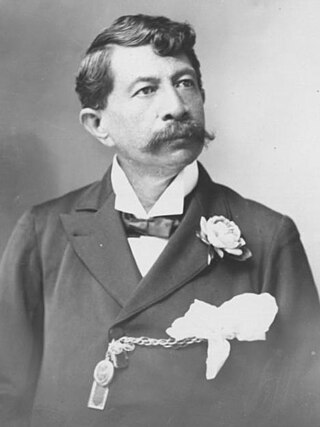Related Research Articles

Lunalilo was the sixth monarch of the Kingdom of Hawaii from his election on January 8, 1873, until his death a year later.

William Pitt Leleiohoku II, born Kalahoʻolewa, was a prince of the Hawaiian Kingdom and member of the reigning House of Kalākaua.

Emma Kalanikaumakaʻamano Kaleleonālani Naʻea Rooke was queen of Hawaii as the wife of King Kamehameha IV from 1856 to his death in 1863. She was later a candidate for the throne but King Kalākaua was elected instead.

Joseph Kahoʻoluhi Nāwahī, also known by his full Hawaiian name Iosepa Kahoʻoluhi Nāwahīokalaniʻōpuʻu, was a Native Hawaiian nationalist leader, legislator, lawyer, newspaper publisher, and painter. Through his long political service during the monarchy and the important roles he played in the resistance and opposition to its overthrow, Nāwahī is regarded as an influential Hawaiian patriot.

Peter Young Kaʻeo Kekuaokalani was a Hawaiian high chief (aliʻi) and politician of the Kingdom of Hawaii. His cousin was Emma, who contended for the throne after the death of Kamehameha. After being diagnosed with leprosy, he was exiled in 1873 to Kalaupapa, the isolation settlement on Molokaʻ. He was later permitted to return to Honolulu, where he died.

The Hawaiian Kingdom, or Kingdom of Hawaiʻi, was a sovereign state located in the Hawaiian Islands. The country was formed in 1795, when the warrior chief Kamehameha the Great, of the independent island of Hawaiʻi, conquered the independent islands of Oʻahu, Maui, Molokai and Lānaʻi and unified them under one government. In 1810, the whole Hawaiian archipelago became unified when Kauaʻi and Niʻihau joined the Hawaiian Kingdom voluntarily. Two major dynastic families ruled the kingdom: the House of Kamehameha and the House of Kalākaua.
The Independent Party was a political party in the Kingdom of Hawaii formed with the purpose of providing resources and benefits of a political party to independent politicians.

John Adams Kuakini Cummins was a member of the nobility of the Kingdom of Hawaii who became a wealthy businessman, and was involved in politics as the kingdom was overthrown.

Albert Kūkaʻilimoku Kūnuiākea was the illegitimate son of King Kamehameha III and his mistress Jane Lahilahi. He served as a politician in the Kingdom of Hawaii and the Republic of Hawaii. He later was baptized into the Anglican Church of Hawaii with the name Albert Fredrick Kunuiakea Oiwiaulani Koenaokalani.

John Mākini Kapena was a politician, diplomat and newspaper editor who served many political roles in the Kingdom of Hawaii. He served as Governor of Maui from 1874 to 1876, Minister of Finance from 1876 to 1878 and again from 1883 to 1886, Minister of Foreign Affairs from 1878 to 1880, Postmaster General from 1881 to 1883 and Collector General of Customs from 1886 to 1887. From 1874 to 1875, he accompanied King Kalākaua on his state visit to the United States to negotiate the Reciprocity Treaty of 1875. In 1882, he traveled to Tokyo as Envoy Extraordinary and Minister Plenipotentiary to the Court of Japan to negotiate Japanese immigration to Hawaii.
Simon Kaloa Kaʻai was a politician who served many political posts in the Kingdom of Hawaii. He served multiple terms as a legislator from the island of Hawaii, Minister of Finance from 1878 to 1880 and from 1882 to 1883 and Minister of the Interior in 1882.

Kapiʻolani was the queen of the Kingdom of Hawaiʻi as the consort of Mōʻī (king) Kalākaua, who reigned from 1874 to 1891 until Mōʻī's death when she became known as the Dowager Queen Kapiʻolani. Deeply interested in the health and welfare of Native Hawaiians, Kapiʻolani established the Kapiʻolani Home for Girls, for the education of the daughters of residents of the Kalaupapa Leprosy Settlement, and the Kapiʻolani Maternity Home, where Hawaiian mothers and newborns could receive care.
Zepherin "Kepelino" Kahōʻāliʻi Keauokalani was a Native Hawaiian cultural historian who wrote Kepelino's Traditions of Hawaii. Born into a family descended from both the Hawaiian priestly class and nobility, Kepelino converted to Roman Catholicism with his family at an early age. He was educated by Catholic missionaries and briefly joined the mission to Tahiti before returning to finish his education in Honolulu. He became an editor of a Hawaiian language newspaper for Hawaiian Catholics and contributed many written works to the history and culture of Hawaii. Serving as a private secretary to Queen Emma of Hawaii, he espoused her candidacy for the throne in the 1874 monarchical election against Kalākaua. After the queen's loss in the election and Kalākaua's accession to the throne, Kepelino became involved in an attempt to overthrow the new king in favor of Queen Emma, which led to his trial and imprisonment for treason.

J. W. Lonoaea was a politician of the Kingdom of Hawaiʻi who served in the House of Representatives of the Legislature of the Kingdom from 1872 until his death. Following the death of King Lunalilo, it fell to the legislature to choose the next monarch from amongst the native-born high chiefs, though only three candidates were considered seriously: Bernice Pauahi Bishop, David Kalākaua, and Queen Emma. Lonoaea voted with the majority in supporting Kalākaua, and was one of the thirteen legislators to be injured by supporters of Queen Emma in the ensuing 1874 Honolulu Courthouse riot. Lonoaea was the only legislator who did not survive his injuries.

Paul Nahaolelua was a Hawaiian high chief who served many political posts in the Kingdom of Hawaii, including Governor of Maui from 1852 to 1874. In his long political career, Nahaolelua served under the reigns of five monarchs: Kamehameha III, Kamehameha IV and Kamehameha V, Lunalilo and Kalākaua.

George Washington Pilipō was a politician of the Kingdom of Hawaii. He served as a member of the House of Representative from North Kona (1860–1884) and Reverend of Kaumakapili Church. Considered one of the leading Hawaiian politicians of his generation, he was known as "Ka Liona o Kona Akau", or "The Lion of North Kona".

Colonel Charles Hastings Judd was a Hawaiian businessman, rancher, courtier and politician who was born, lived, worked and died in the Kingdom of Hawaii. He served as chamberlain and colonel of the military staff of King Kalākaua and traveled with the monarch on his 1881 world tour.
Pius F. Koakanu was a Hawaiian high chief (aliʻi) from the island of Kauai who served as a politician during the Kingdom of Hawaii and the Kahu or Keeper of the Royal Mausoleum of Hawaii at Mauna ʻAla.

Moses Kuaea was a Native Hawaiian clergyman and politician of the Hawaiian Kingdom. He was pastor of the Kaumakapili Church from 1874 to 1882 and was known as an eloquent preacher. During his time at the pulpit, he helped fundraise for the second building of the church which was completed in 1888 and later burned down in 1900. In 1874, he gave a speech lauding the new elected King Kalākaua prior to his state visit to the United States. After Kalākaua's return to Hawaii, he appointed Kuaea a member of the Privy Council of State and as his Minister of Finance from August 14 to September 27, 1880. After his brief stint in politic, Kuaea returned to preaching at Kaumakapili until his resignation in 1882 due to illness. He died in 1884.

Edward Kamakau Lilikalani was a political protégé of King Kalākaua of Hawaiʻi. He served more than a decade in the lower house of the Legislature of the Hawaiian Kingdom, and after nearly two decades out of office, was elected to the same legislative body under the Territory of Hawaii. Lilikalani was a member of both Kalākaua's Privy Council of State and Liliʻuokalani's Privy Council of State. Kalākaua decorated him with the Royal Order of Oceania, Order of Oceania, Order of Kalakaua, and Order of Kapiolani.
References
- Kanahele, George S. (1999). "Ka ʻIke O Ke Keiki, The Child Learns". Emma: Hawaii's Remarkable Queen. University of Hawaii Press. pp. 26, 29–30, 32, 34, 39, 52. ISBN 0-8248-2240-4.
- Kuykendall, Ralph S. (1967). The Hawaiian Kingdom.: Volume 3--The Kalakaua Dynasty, 1874-1893. University of Hawaii Press.
- Erskine, Steuart (1905). Beautiful Women in History & Art. George Bell & Sons.
